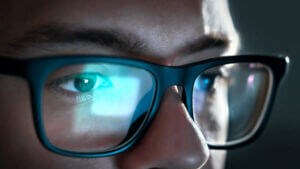Blue Light Filters: Fact vs. Myth?
&srotate=0)
I get questions about blue light glasses every day. Are they a good idea? The answer depends on what problem you think they solve.
On the one hand, blue wavelengths are known to cause oxidative damage to retinal cells, and a lifetime of exposure does appear to contribute to cataract formation and the development of macular degeneration.
The natural human lens filters out most harmful blue and ultraviolet rays. When the lens is removed – in cataract surgery – the loss of this natural barrier was found to contribute to retinal degeneration. To solve this issue, intraocular lens implants now include a coating to filter out harmful wavelengths.
In theory, blue light emissions from computers might contribute to similar ocular problems. However, the amount of exposure from technology turns out to be far below that which would cause significant risk. In fact, the exposure from blue skies and sun lights probably more than that experience for an entire day spent video gaming.
On the other hand, prolonged technology use and light exposure cause several issues aside from cataract and macular degeneration risk.
Evolution proceeded under the assumption that light meant daytime and darkness night. Exposure to bright or white light after sunset messes with this natural rhythm, disrupting melatonin levels, and sleep patterns.
I advise limiting technology use in the hour before sleep. Recognizing that this is a difficult battle (especially with teenagers), I recommend light control programs like f.lux (https://justgetflux.com/), or – at a minimum – switching phone/tablet settings, such that there are white letters on a black background.
Finally, one should consider the effects of prolonged near work in general. To view material up close, the eyes have to change focus and converge. These two actions performed over a prolonged period can’t produce tired eyes, dry eyes, eye strain, double vision, and overall fatigue.
Benjamin H. Ticho, MD